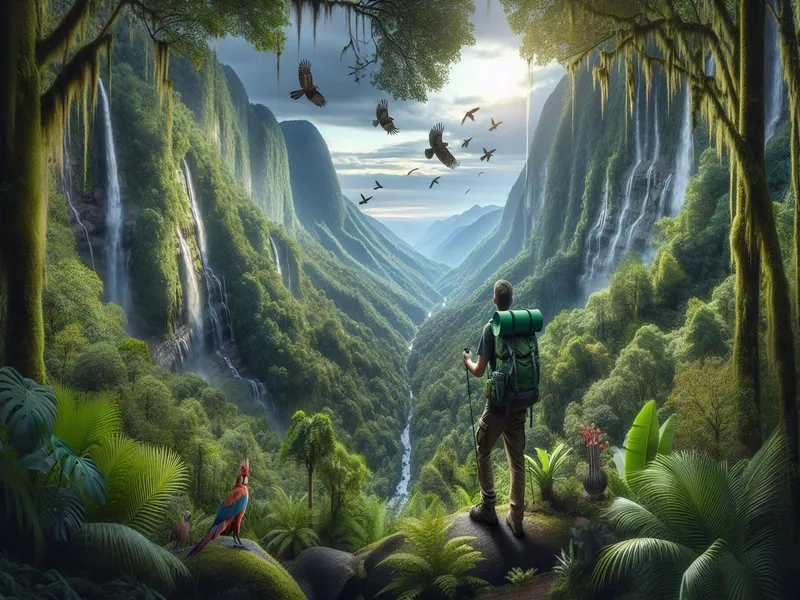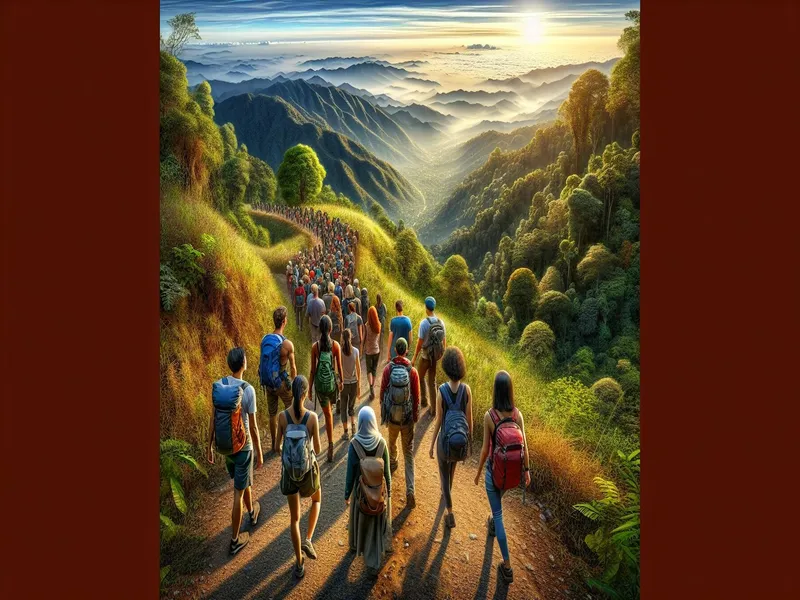the ultimate Chiang Mai trekking adventure! Explore misty jungles, serene hill tribe villages, and breathtaking waterfalls. Immerse in rich Thai culture and nature.

An Overview Of Chiang Mai Trekking
Trekking in Chiang Mai is like stepping into a nature documentary. Picture this: lush jungles, mist-covered mountains, and remote hill tribe villages that seem frozen in time. If you’re looking for an adventure that offers more than just pretty views, you’ve found the right place.
What To Expect
When you hit the trails in Chiang Mai, expect diversity. Some treks take you through dense forests teeming with wildlife , while others lead to tranquil waterfalls where you can cool off after a long hike.
- Lush Landscapes: The greenery here feels almost surreal, especially during the rainy season (June to October).
- Hill Tribe Villages: You’ll meet locals from tribes like the Karen and Hmong. They often invite trekkers for a meal or even an overnight stay.
- Varied Difficulty Levels: Whether you’re a newbie or a seasoned hiker, there’s a trail for you.
Personal Highlights
One of my favorite treks was to Doi Inthanon National Park. It’s home to Thailand’s highest peak! We started at dawn and by midday we were surrounded by clouds—literally walking above them. During another trip, I stayed overnight in a Lahu village where I learned how they weave their traditional clothes.
Essential Gear Checklist
Packing smart makes your trek smoother:
- Sturdy Hiking Boots: Trust me, you’ll need them.
- Lightweight Rain Jacket: Weather can be unpredictable.
- Water Bottle & Purification Tablets: Staying hydrated is key.
- Snacks: Energy bars and dried fruits are lifesavers.
Budgeting Your Trek
Trekking doesn’t have to expensive:
| Item | Estimated Cost ($) |
|---|---|
| Guided Tour | 30 – 100 per day |
| Accommodation | 10 – 20 per night |
| Meals | 5 – 15 per meal |
You could easily spend less than $50/day if you’re budget-conscious. Many guided tours include meals and accommodation in local homes .
- Doi Suthep-Pui National Park has over 300 bird species!
- The area is known as “The Rose of the North” due to its stunning flora .
- You might see gibbons swinging through trees if you’re lucky!
So there it is—a sneak peek into trekking heaven! Whether it’s breathtaking landscapes or cultural encounters, Chiang Mai trekking offers something unforgettable for every adventurer out there.
Popular Trekking Routes

Exploring Chiang Mai’s trekking routes is like stepping into another world. Whether you’re an experienced hiker or a casual wanderer, there’s something for everyone.
Doi Inthanon National Park
Doi Inthanon National Park offers some of the best trekking in Thailand. It’s home to Thailand’s highest peak, standing at 8,415 feet (2,565 meters). I remember my first trek here; the trails are lush and green, especially during the rainy season. You’ll traverse through dense forests and past cascading waterfalls like Wachirathan Waterfall, which is simply breathtaking.
Here’s a quick checklist for your Doi Inthanon adventure:
- Sturdy hiking boots
- Lightweight rain jacket
- Hydration supplies
You can also visit the Twin Royal Pagodas with panoramic views that’ll leave you speechless. The park has diverse flora and fauna—keep an eye out for exotic birds! If you’re lucky, you might spot one of those rare mountain birds that birdwatchers rave about.
Chiang Dao Trek
Chiang Dao Trek is perfect if you’re looking to immerse yourself in nature and culture. This trek takes you up to Chiang Dao Mountain, which stands tall at 7,135 feet (2,175 meters). One of my favorite memories here was staying overnight in a Lahu village. The villagers were so welcoming; they even showed me traditional weaving techniques!
Expect steep climbs but it’s worth it when you see the limestone caves and temples along the way. Here’s what you’ll need:
- Comfortable backpack
- Headlamp (for exploring caves)
- Snacks (energy bars are lifesavers)
The whole experience feels like stepping back in time with serene jungle paths dotted with ancient shrines and wildlife sightings.
Mae Wang National Park
Mae Wang National Park is ideal for those who love water adventures combined with their hikes. Picture this: trekking through bamboo forests only to end up rafting down the Mae Wang River on a bamboo raft! It’s exhilarating! During my visit last summer, we ended our day by swimming under a secluded waterfall—it felt straight out of a movie scene.
For Mae Wang treks:
- Waterproof gear
- Swimwear
- Insect repellent
You’ll pass through Karen villages where locals live traditionally; it’s humbling to see their simple lifestyle amidst such natural beauty.
Best Time To Trek In Chiang Mai

When thinking about trekking in Chiang Mai, timing is everything. You don’t wanna get caught in the rain or miss out on those stunning views due to fog. So, let’s break it down and find the perfect time for your adventure!
Cool Season (November to February)
This is my favorite time!
- Weather: The cool season offers mild temperatures, ranging from 59°F to 86°F. Perfect for trekking!
- Pros: Crystal-clear skies, minimal rainfall, and lush green landscapes.
- Cons: It’s peak tourist season, so trails can be crowded.
During these months, the weather’s just right—think warm days and cool nights. I remember one trek where we woke up to a chilly morning mist with a hot cup of Thai coffee. Pure bliss.
Hot Season (March to May)
Not for the faint-hearted.
- Weather: Temperatures soar from 95°F to 104°F.
- Pros: Fewer tourists mean quieter trails.
- Cons: It gets extremely hot during the day; dehydration is a real risk.
I’ve trekked during this period once. Trust me; you’d need plenty of water and some serious sun protection gear. But hey, if you love having trails all to yourself, go for it!
Rainy Season (June to October)
For the adventurous souls.
- Weather: Frequent rains with temperatures around 77°F to 86°F.
- Pros: Lush greenery and fewer tourists.
- Cons: Muddy trails and slippery rocks.
The rainy season transforms Chiang Mai into a green paradise but makes trekking trickier. One time I slipped on a muddy trail—it was messy but memorable! If you’re up for an adventure, this could be your time.
| Season | Temperature Range | Pros | Cons |
|---|---|---|---|
| Cool | 59°F – 86°F | Clear skies & lush greenery | Crowded trails |
| Hot | 95°F – 104°F | Quieter trails | Extreme heat |
| Rainy | 77°F – 86°F | Vibrant landscapes | Slippery conditions |
- Pack according to season: Lightweight clothing for hot seasons; waterproof gear for rainy seasons.
- Stay hydrated: Always carry extra water bottles.
- Footwear matters: Invest in good trekking boots with grip—you’ll thank me later!
Essential Gear And Preparations
When you’re gearing up for a trek in Chiang Mai, having the right gear and making the necessary preparations can make all the difference. Trust me, from my own experiences, being well-prepared means you’ll enjoy every minute of your adventure.
Packing List
First things first, let’s talk about what to pack. You don’t want to overpack, but missing out on essentials can be a bummer. Here’s my go-to list:
- Sturdy Hiking Boots: Blisters are no fun! Make sure your boots are broken in.
- Lightweight Rain Jacket: The weather in Chiang Mai can be unpredictable; a rain jacket is a lifesaver.
- Hydration Supplies: A good water bottle or hydration pack is crucial . Remember, dehydration sneaks up on you!
- Comfortable Backpack: Look for one with padded straps and a waist belt.
- Quick-Dry Clothing: Opt for moisture-wicking fabrics. Trust me, cotton isn’t your friend here.
- First Aid Kit: Better safe than sorry—include band-aids, antiseptic wipes, and painkillers.
- Snacks: High-energy snacks like nuts or protein bars keep you going.
Here’s a quick comparison table to help you decide what might work best for you:
| Item | Must-Have | Nice-to-Have |
|---|---|---|
| Hiking Boots | ✔️ | |
| Rain Jacket | ✔️ | |
| Hydration Pack | ✔️ | |
| Backpack | ✔️ | |
| Quick-Dry Clothes | ✔️ | |
| First Aid Kit | ✔️ | |
| Snacks | ✔️ |
Physical Preparation
Now that we’ve got our gear sorted out ️ let’s talk about getting physically ready for those trails.
Start with some basic cardio exercises like running or biking at least three times a week. This helps build stamina. Do these workouts gradually longer each time so you’re not winded halfway through your trek.
Incorporate strength training into your routine as well. Focus especially on legs and core muscles because they take most strain while trekking uphill or exploring uneven terrain.
And don’t forget flexibility! Simple yoga stretches can prevent muscle cramps during long hikes (they work wonders!).
I remember my first trek – I thought I was fit until the third hour hit My legs were jelly! So trust me when I say conditioning yourself pays off big time.
What To Expect On A Trek
When you head out for a trek in Chiang Mai, you’ll find yourself surrounded by stunning landscapes and vibrant cultures. Here’s what you can look forward to:
Wildlife And Nature
Chiang Mai’s trekking routes are packed with natural wonders. Imagine lush green forests teeming with life. You might spot gibbons swinging through trees or colorful butterflies fluttering around. Don’t be surprised if you hear the call of exotic birds – it’s like nature’s own soundtrack.
During my last trek, I stumbled upon a hidden waterfall deep within the jungle. It was such a refreshing break from the hike and an ideal spot for cooling down. Keep your eyes peeled for wild orchids; they’re scattered throughout the trails, adding pops of color to the greenery.
Here’s a quick checklist of what you’ll see:
- Dense jungles: Home to diverse flora and fauna
- Waterfalls: Perfect spots for a dip
- Wildlife: Gibbons, butterflies, exotic birds
- Unique plants: Wild orchids and giant ferns
Remember to bring a camera – trust me, you’ll want to capture these moments.
Cultural Encounters
One of the highlights of trekking in Chiang Mai is meeting local hill tribes like the Karen and Hmong people. These encounters offer a glimpse into their way of life that’s both fascinating and humbling. You’ll get to see traditional houses made from bamboo and thatch, which blend seamlessly into their surroundings.
During one trek, I stayed overnight in a Lahu village. The community welcomed us with open arms, sharing stories around a campfire while we tasted delicious homemade dishes like sticky rice wrapped in banana leaves .
What’s even cooler? Sometimes you can participate in cultural practices like weaving or cooking lessons:
- Karen tribe: Known for intricate weaving techniques
- Hmong tribe: Famous for vibrant clothing and embroidery
- Lahu village stay: Experience daily life firsthand
Don’t miss out on these opportunities – they add so much depth to your adventure!
Chiang Mai trekking offers an unparalleled adventure for those seeking to immerse themselves in nature and culture. Walking through misty jungles, visiting serene hill tribe villages, and experiencing the vibrant local traditions create memories that last a lifetime.
Whether you’re exploring lush trails at Doi Inthanon National Park or diving into cultural experiences at Lahu villages, there’s something magical about every step you take. With proper preparation and timing your trek can be both safe and unforgettable.
For anyone looking to combine physical challenge with cultural enrichment Chiang Mai’s diverse trekking routes provide the perfect escape. So lace up your boots pack wisely and get ready for an extraordinary journey through northern Thailand’s captivating landscapes.